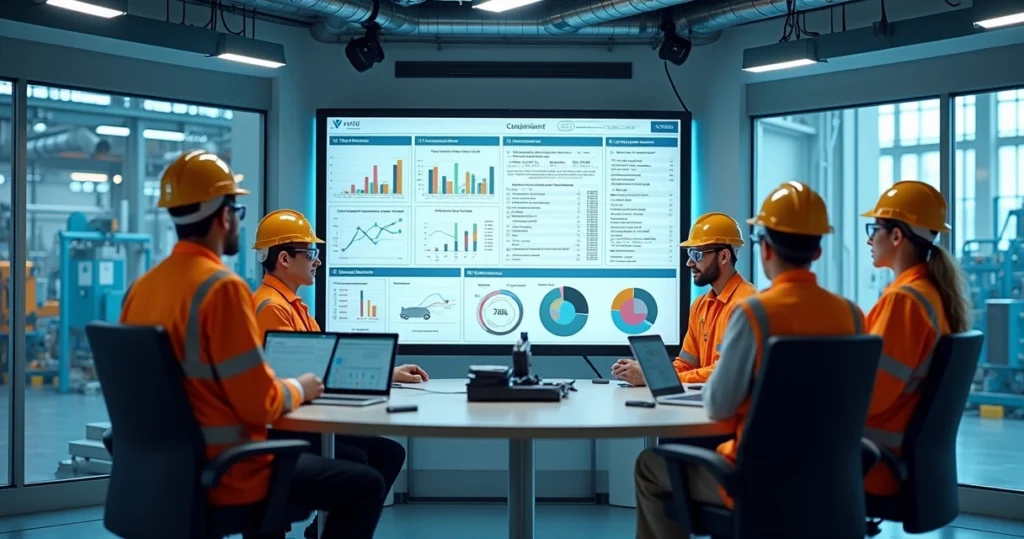How to Simplify Compliance Audits With Automated Reporting

Anyone who has ever sat in a windowless meeting room surrounded by binders, spreadsheets, and the nervous energy of an audit team knows this isn’t an easy process. Compliance audits mean pressure. Scrambled emails. Sifting through long reports and missing just one attachment can derail an entire audit cycle. The reality is, for many industrial teams, compliance checks can turn a routine week into a small storm. But does it have to be this way?
Automated reporting is changing how compliance audits unfold. By moving from manual data entry and late-night cross-checking to real-time data capture and instantly generated reports, teams are transforming this once-dreaded process into something almost… manageable. Not perfect, but undeniably better.
Why compliance audits create stress
Compliance audits have a reputation for being complex and disruptive. Auditors usually want everything: detailed breakdowns, historical records, root cause analyses, and evidence that problems have been solved—not just patched. Teams spend valuable time organizing paperwork, reconstructing events from memory, and worrying about mistakes that could create bigger issues down the line.
A major reason for this anxiety? Much of the work has been done by hand. When information is scattered across systems, handwritten notes, or disconnected software, even a simple request can snowball into hours (or days) of detective work. If your team works with industrial equipment, the stakes rise: lost time may impact safety, compliance, and even plant performance.
No one ever asked for another spreadsheet.
How automated reporting creates clarity
Automated reporting promises one thing: it takes repetitive, error-prone manual work and turns it into fast, accurate data processing. When audit time comes, instead of scrambling, teams can present standardized, automatically generated documentation and focus on genuine problem-solving.
What does this look like in everyday work? Imagine not having to collect signatures by hand, double-check values on every checklist, or wonder when equipment maintenance was documented and by whom.
- Data is collected at the source, immediately
- Pre-set templates ensure consistency
- Full audit trails show who did what, and when
- Errors from double entries or missed fields are nearly eliminated
A study by Deloitte showed that organizations can reduce compliance costs by up to 30% with automation, while McKinsey estimates time spent on compliance can fall by 50-70%. That’s not just a time savings; it’s peace of mind and a serious reduction in stress.

The key benefits of automation for compliance
The numbers aren’t difficult to find: McKinsey & Company found automation can reduce compliance costs by up to 30% and improve work speed dramatically. But the story goes deeper than numbers. Let’s look at tangible improvements, especially in industries where compliance rules evolve and pressure is high.
Accuracy and fewer mistakes
Automated compliance reporting systems can reduce data entry errors by about 90%, as noted by the Institute of Internal Auditors. That means if your team dreaded reviews because of messy records, you can now trust the system to make sense of things. Fewer mistakes, fewer sleepless nights.
Faster audits and tighter operations
Surveys show automated reporting can shrink audit cycles by up to 40%. The time saved allows teams to focus on serious, strategic work instead of time-consuming checks (see survey numbers here), even in plants running around the clock.
Better risk reduction
A PwC report highlights that 85% of companies using automation in compliance said their risk management got better and their data was more accurate. It’s easier to address risks when issues are flagged fast and data is easy to find.
Why teams are reluctant to make the switch
But let’s be honest: not every team or company makes this leap easily. People worry about costs, setup effort, and whether technology might somehow “miss” something that a person would catch. Old habits persist; sometimes paper and pen feel strangely comforting.
The story is rarely straightforward. Some teams test out automation, find a few rough edges, and wonder if it’s worth it. Others—once they get their first quick audit turnaround—can’t imagine going back. Productivity gains are hard to ignore, and the sense of control over workflow is real.
Integrating automated reporting without headaches
Here’s something I see a lot: companies wanting to adopt new technology but worried about integration. Usually, the existing maintenance or reporting system is so entrenched, no one wants to risk breaking it.
Solutions like Prelix are built to fit into what’s already there. Prelix, for example, connects with any existing maintenance management system. It can diagnose failure causes in real time, generate 5 Whys analysis automatically, and create detailed diagrams—automatically. This reduces manual labor and increases the confidence that all required details are captured. Teams using platforms like Prelix have even reported smoother audit processes, and you can read more about these experiences in various languages on our blog.
- English: How to simplify compliance audits with automated reporting
- Portuguese: Como simplificar auditorias regulatórias com relatórios automatizados
- German: Wie man Compliance-Prüfungen mit automatisierten Berichten vereinfacht
- French: Comment simplifier les audits de conformité avec les rapports automatisés
- Spanish: Cómo simplificar las auditorías de cumplimiento con informes automatizados
Simple steps to get started
- Map current compliance processes and pain points. Be honest about what’s working and what’s a mess.
- Seek solutions that allow for easy integration and don’t require huge training up front.
- Pilot with a small team—perhaps the crew most open to change or where compliance is trickiest.
- Track results: measure time savings, mistake rates, and user feedback.
You might see a mix of outcomes at first. Not every hiccup is a setback. If the majority of tasks get easier and audits get less stressful, you’re on the right track.

What slows adoption: fears and facts
A question I often hear: “Isn’t it too expensive for what we get?” The answer can be complicated, but McKinsey research finds the payback is usually fast—a few months, sometimes less for high-volume or high-risk operations. The real risk isn’t trying automation; it’s falling behind while others move ahead.
Compliance doesn’t wait until you’re ready.
Another concern is security. With the right technology, sensitive data is protected with role-based access, encryption, and strict audit histories. Reliable automated reporting platforms are built with these protections in mind, recognizing the stakes involved.
Compliance audits can become routine again
It’s a bit strange to imagine, but compliance audits don’t have to create dread or lost sleep. With reliable automated reporting—especially for industrial teams—data is accurate, reports are ready when needed, and the process actually adds value rather than just meeting requirements.
For those ready to take the next step, solutions like Prelix are designed to slot into your workflow, making every report, root cause analysis, and compliance check just a bit easier, and a lot more reliable. If you’re curious what routine, stress-free audits can feel like, this is the time to see what automated reporting means for your team.
Start transforming compliance from a burden into a tool.
Want to see how much smoother your audits can be? Reach out to Prelix today and discover what less stress and more clarity can do for your maintenance operations.
Frequently asked questions about automated compliance reporting
What is automated compliance reporting?
Automated compliance reporting is a process where software systems collect, organize, and generate reports needed for regulatory or industry audits without manual effort. The system automatically pulls relevant data from connected sources and organizes it into standard formats, making it easier to prepare documentation needed for audits. This reduces manual work, makes error tracking faster, and helps maintain a full record of every step taken.
How does automation simplify compliance audits?
Automation simplifies audits by handling routine data collection and report generation in real time. Instead of relying on memory or scattered notes, teams have instant access to complete records. This shortens audit prep, minimizes mistakes, and reduces back-and-forth with auditors. According to studies, automated reporting can cut audit cycle times by up to 40%, meaning faster results and less stress for your team.
Is automated reporting worth the cost?
Most studies say yes. The upfront investment often pays for itself in saved work hours, fewer errors, faster audits, and avoiding compliance penalties. Reports from sources like McKinsey show that companies can reduce compliance costs by up to 30% while boosting productivity by over 70%. For operations with frequent audits, the savings add up quickly.
How secure is automated audit reporting?
Security is always top of mind. Reliable automated compliance tools use encryption, secure access controls, and detailed audit trails so data is protected at every step. Most platforms update regularly to address new threats. Teams still need to set appropriate user permissions, but with strong software foundations, sensitive compliance data stays protected.
What are the best tools for reporting?
The best tool is one that fits your existing workflow, is easy for your team to learn, and can integrate with your data sources without extra hassle. Solutions such as Prelix allow industrial teams to get started quickly, improve how they track maintenance issues, and automate the creation of compliance-ready reports. For more perspectives on this topic, you can read user experiences and practical tips at the Prelix blog available in several languages.
